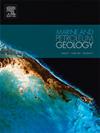A novel method for automatic quantification of different pore types in shale based on SEM-EDS calibration
IF 3.7
2区 地球科学
Q1 GEOSCIENCES, MULTIDISCIPLINARY
引用次数: 0
Abstract
Pore type is a crucial consideration in the quantification of shale pores. Convolutional Neural Networks (CNNs) are widely used for identifying pore types in shale, but it is hampered by feature extraction bias, difficult data labeling, and poor generalization ability. Compared to secondary electron (SE) images, mineral distribution maps have low resolutions that pose a significant obstacle to pore type identification. This paper presents a method for identifying and quantifying pore types based on pore-matrix contact relationships. Organic matter, organic pores, and inorganic pores are extracted from SE images using the edge-threshold automatic processing (ETAP) method. Next, the labeled watershed algorithm is used to improve the low-resolution mineral distribution map to the SE image level. The high-resolution mineral distribution map is then combined with pore extraction images, permitting the identification of pore types. Finally, pore size, surface porosity, generalized fractal dimension, and contact angle are calculated for each pore type. We used this new method to identify pores in images of the Longmaxi, Qiongzhusi, and Qingshankou shale. We found that high-resolution mineral distribution maps significantly enhance pore identification accuracy. The Longmaxi Formation clay-rich shale is dominated by organic pores (over 60%), while the Qiongzhusi Formation siliceous shale is characterized by intergranular pores and fractures (fractures contributing 30%). In the Qingshankou Formation clay-rich shale, clay pores (35%) and cracks dominate, whereas the Qingshankou Formation siliceous shale is primarily composed of intergranular pores (17%) and cracks (30%), with distinct pore size distributions across these lithofacies. There is a significant difference in the wettability of the matrix and pores of the Longmaxi shale, primarily due to the dominant influence of organic matter on the pore surfaces.
求助全文
约1分钟内获得全文
求助全文
来源期刊

Marine and Petroleum Geology
地学-地球科学综合
CiteScore
8.80
自引率
14.30%
发文量
475
审稿时长
63 days
期刊介绍:
Marine and Petroleum Geology is the pre-eminent international forum for the exchange of multidisciplinary concepts, interpretations and techniques for all concerned with marine and petroleum geology in industry, government and academia. Rapid bimonthly publication allows early communications of papers or short communications to the geoscience community.
Marine and Petroleum Geology is essential reading for geologists, geophysicists and explorationists in industry, government and academia working in the following areas: marine geology; basin analysis and evaluation; organic geochemistry; reserve/resource estimation; seismic stratigraphy; thermal models of basic evolution; sedimentary geology; continental margins; geophysical interpretation; structural geology/tectonics; formation evaluation techniques; well logging.
 求助内容:
求助内容: 应助结果提醒方式:
应助结果提醒方式:


